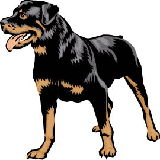Big DogsInformation About The Rottweiler Dog Breed |
|
|
History and origin : The Rottweiler comes from the West German town of Rottweil in Wurttemberg. He was used as a cattle drover and guard dog in Germany. Description : Rottweilers stand 22 to 27 inches at the shoulder and weigh between 70 and 120 pounds, with the males slightly larger than the females. With a docked tail and powerful thick muscles, the Rottweiler has a big-boned body and a coarse mid-length coat that sheds but is relatively easy to maintain, requiring regular brushing to keep it in good condition. About the breed : The Rottweiler is a German working dog of high intelligence. He has been used as a herder and is still used today as a sled dog, police dog, guard dog, and mountain rescue dog. He is a large, heavily muscled dog possessing strength and courage. He is by nature one of the most territorial breeds. Highly suspicious of strangers, the Rottweiler will guard his owner's house and yard with savagery if necessary. He should not be kept in a place where people often walk such as a chain-link fence next to a sidewalk. This will encourage him to fence-fight and become aggressive. Keep this breed inside the house, where it can guard your home more effectively. He is extremely dominant and pushy, and likes to use his big body to control you by leaning and pushing on you. He responds best to kind and firm handling, not being chained or kenneled. Training and socialization needs to begin early on. Handling must start from puppy hood because this breed does not like to be handled, particularly on his feet. Clip his nails at least twice a week, starting when he is a puppy. A confident, well-bred Rottweiler that has received firm early training and has not been spoiled can be a great pet. When acquired from a diligent breeder and trained properly, a Rottweiler can be an admirable, courageous, loyal dog capable of a high level of obedience. The Rottweiler often suffers from hip dysplasia and shoulder problems. Structural problems can be exaggerated by allowing the dog to become overweight. Hip or shoulder pain in a Rottweiler may not be discernible to an owner because this breed can tolerate pain quite effectively, but this pain-masking can result in aggression toward the owner when the dog does not want to be touched in a sensitive area. The Rottweiler puppy is very susceptible to canine parvovirus, a highly contagious viral disease that attacks bone marrow, intestinal, lymph, and heart cells and could die if not given the proper shot. Feeding : Recommended feeding for the Rottweiler is 1 ½ - 2 ½ cans (13.3oz) of high-quality meaty product with biscuit added in equal amount or 5 cupfuls of a complete, dry food. Ideal home : A house with a fenced yard is best for the Rottweiler, though you should not leave him in the yard all day. The owner of a Rottweiler must be a strong and firm leader who sets rules and sticks to them. Do not consider this breed if you are nurturing, disabled, or elderly, if you have children, or if you do not have enough time to train the dog. Also, do not get more than one at a time, and do not get litter mates. They will bond more closely to each other than to you and create behavioral nightmares. If you live by yourself and want a dog you can feel safe with, a Rottweiler might be for you. You must prove your leadership every day to this breed. If you choose a Rottweiler, spend a lot of time finding a good breeder. Also keep in mind that females tend to be more aggressive. Back to the Big Dog Breed article page
| |
|
Related News About Dogs ' ); // get rid of newsfeed display by carp CarpConf('poweredby',''); CarpCacheShow('http://classifieds.agriscape.com/syndicate/dogs.rss'); ?>
|
|
|
|
|
|
Copyright © 2006-2007 dogguidance.com |


